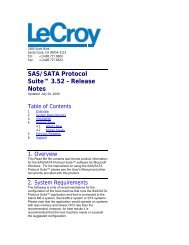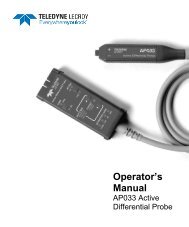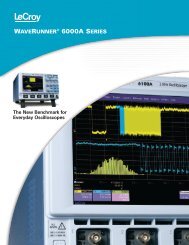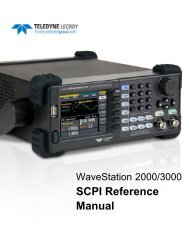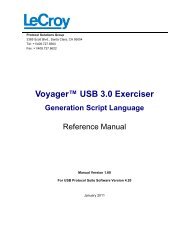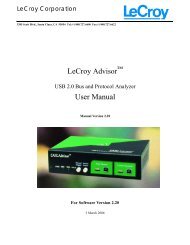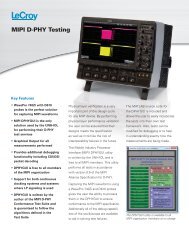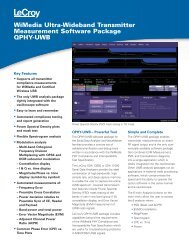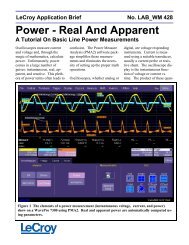LAB 811 - Using the Remote Control Assistant - Teledyne LeCroy
LAB 811 - Using the Remote Control Assistant - Teledyne LeCroy
LAB 811 - Using the Remote Control Assistant - Teledyne LeCroy
You also want an ePaper? Increase the reach of your titles
YUMPU automatically turns print PDFs into web optimized ePapers that Google loves.
<strong>LeCroy</strong> Application Brief No. L.A.B. <strong>811</strong><br />
<strong>Using</strong> <strong>the</strong> <strong>Remote</strong> <strong>Control</strong> <strong>Assistant</strong><br />
How your oscilloscope can help debug your source code<br />
If you have wondered why your<br />
oscilloscope occasionally beeps<br />
and displays <strong>the</strong> message<br />
“<strong>Remote</strong> <strong>Control</strong>: problem<br />
detected and logged. (RCI),”<br />
<strong>the</strong>n this Operating note should<br />
be of assistance to you.<br />
The <strong>LeCroy</strong> 93XX, LCXXX,<br />
and Waverunner (LT) series of<br />
oscilloscopes and <strong>the</strong> LSA1000<br />
embedded signal analyzers are<br />
outfitted with a feature called<br />
<strong>Remote</strong> <strong>Control</strong> <strong>Assistant</strong>.<br />
(Firmware levels 7.6.0 and<br />
above.) When enabled, <strong>the</strong><br />
“RCA” will maintain a log of<br />
GPIB or RS232 remote<br />
commands received and<br />
responses issued, allowing <strong>the</strong><br />
programmer to receive feedback<br />
on errors in his or her source<br />
code.<br />
The RCA has several modes of<br />
operation: Off, Errors only,<br />
Full Dialog, and RS232. In<br />
Errors Only mode, <strong>the</strong> RCA will<br />
keep a log of any mistakes in <strong>the</strong><br />
commands received, and display<br />
<strong>the</strong> error shown in Figure 1<br />
when an error has been detected.<br />
In Full Dialog mode, all<br />
commands and responses are<br />
logged. In RS232 mode, all<br />
dialog is echoed to <strong>the</strong> RS232<br />
port. (This mode is only active<br />
when using GPIB for remote<br />
operation. RS232 mode is not<br />
available for <strong>the</strong> LSA1000<br />
series.) The default mode is<br />
Errors Only.<br />
Figure 1 – Example <strong>Remote</strong> <strong>Control</strong> <strong>Assistant</strong> screen, set for Errors Only,<br />
and displaying several types of errors.<br />
The RCA can be setup,<br />
monitored and cleared via <strong>the</strong><br />
oscilloscope front panel or<br />
through remote control. From<br />
<strong>the</strong> front panel, press <strong>the</strong><br />
Utilities button, followed by<br />
Special Modes and <strong>the</strong>n<br />
<strong>Remote</strong> Ctrl. <strong>Assistant</strong> to view<br />
<strong>the</strong> <strong>Remote</strong> <strong>Control</strong> <strong>Assistant</strong><br />
screen and menu. From this<br />
point, <strong>the</strong> logging mode can be<br />
selected, and any errors (or <strong>the</strong><br />
entire dialog) can be viewed and<br />
cleared via a knob and button on<br />
<strong>the</strong> oscilloscope front panel.<br />
To operate <strong>the</strong> RCA by remote<br />
control, use <strong>the</strong> commands<br />
COMM_HELP (or its short<br />
form: CHLP) and<br />
COMM_HELP_LOG (CHL).<br />
CHLP is used to setup <strong>the</strong><br />
logging mode, and accepts an<br />
argument that determines <strong>the</strong><br />
level: OFF, EO, FD, and RS for<br />
Off, Errors Only, Full Dialog,<br />
and RS232 respectively. The<br />
remote query CHL returns <strong>the</strong><br />
contents of <strong>the</strong> log, in commadelimited<br />
format. Use <strong>the</strong><br />
command CHL CLR to both<br />
read and clear <strong>the</strong> RCA.<br />
The log in Figure 2 shows<br />
examples of several types of<br />
errors. For example, <strong>the</strong> line “at<br />
token : unknown
command” indicates that VDV is<br />
not recognized (in this case,<br />
VDIV is <strong>the</strong> correct command).<br />
Some of <strong>the</strong> errors in figure 2<br />
are obvious (such as<br />
“700MVV”, which should be<br />
“700MV”), but <strong>the</strong>re are many<br />
potential errors that can be<br />
harder to find. For example, <strong>the</strong><br />
correct syntax for “MAXPT<br />
10000” should be “MAXPTS,<br />
10000”.<br />
While <strong>the</strong> <strong>Remote</strong> <strong>Control</strong><br />
<strong>Assistant</strong> is best used during <strong>the</strong><br />
development stage of a program,<br />
users may want to utilize<br />
additional commands and<br />
registers that report remote<br />
control errors once <strong>the</strong><br />
application is running smoothly.<br />
In this way, remote control<br />
errors caused by<br />
communications problems<br />
(faulty or noisy cables, etc.) can<br />
be detected and trapped in errorhandling<br />
subroutines.<br />
The CMR and EXR queries<br />
report error conditions, such that<br />
a value greater than 0 indicates<br />
that ei<strong>the</strong>r a command or<br />
execution error has occurred.<br />
See <strong>the</strong> <strong>Remote</strong> <strong>Control</strong> manual<br />
for information on interpreting<br />
<strong>the</strong> results of <strong>the</strong>se queries.<br />
SRQ users can also setup <strong>the</strong><br />
oscilloscope such that a remote<br />
control error generates a valid<br />
SRQ condition, and notifies <strong>the</strong><br />
GPIB controller.<br />
Many users are surprised at <strong>the</strong><br />
number of coding errors detected<br />
by <strong>the</strong> RCA after upgrading<br />
from previous versions of<br />
firmware that did not include<br />
<strong>LeCroy</strong> Application Brief No. L.A.B. <strong>811</strong><br />
Figure 2 – Example <strong>Remote</strong> <strong>Control</strong> <strong>Assistant</strong> screen, with <strong>the</strong> logging<br />
level set to “Errors Only.” Several types of errors are shown.<br />
this feature. Coding errors can<br />
be subtle, and commands that<br />
have been sent erroneously do<br />
not necessarily cause a user’s<br />
program to misbehave in any<br />
obvious way.<br />
For example, if a program<br />
continually adjusts <strong>the</strong> volts per<br />
division setting with <strong>the</strong> VDIV<br />
command (perhaps to match <strong>the</strong><br />
voltage range of a predictably<br />
changing input signal), but in<br />
one case has programmed<br />
“VDV” by mistake, <strong>the</strong><br />
oscilloscope will still<br />
successfully trigger, perform<br />
math, transfer data, etc. If <strong>the</strong><br />
desired change in <strong>the</strong> volts per<br />
division setting is small, <strong>the</strong>n<br />
such an error might go<br />
undetected.<br />
An error in setting <strong>the</strong> memory<br />
length via <strong>the</strong> MSIZ command<br />
can cause <strong>the</strong> oscilloscope to<br />
select a smaller sample rate than<br />
desired, with potentially<br />
undesirable consequences such<br />
as inaccurate or incorrect<br />
parameter measurements and<br />
aliasing.<br />
Careful programming can help<br />
<strong>the</strong> user avoid <strong>the</strong> problems<br />
discussed above (i.e. through <strong>the</strong><br />
use of subroutines and string<br />
constants). Frequently, <strong>the</strong> user<br />
is not <strong>the</strong> original programmer,<br />
and is adapting someone else’s<br />
code, or is modifying a driver<br />
written for a different<br />
instrument. In <strong>the</strong>se<br />
circumstances, <strong>the</strong> value of <strong>the</strong><br />
<strong>Remote</strong> <strong>Control</strong> <strong>Assistant</strong> is<br />
readily apparent.



